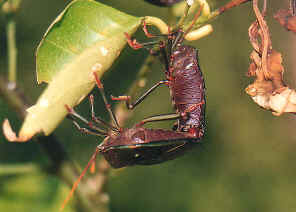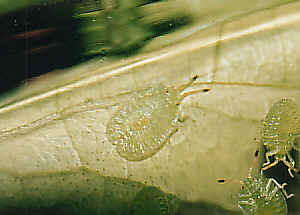Family Tessaratomidae
Family Tessaratomidae is a small family very close to family Pentatomidae. All members in this family look like pentatomid except they are large and with very small head. We only found one species in this family.
Bronze Orange Bug - Musgraveia sulciventris
This page contains pictures and information about Bronze Orange Bugs that we found in the Brisbane area, Queensland, Australia.

- Length 25mm
- Bronze Orange Bugs are very large bugs. Their is body fat and thick. They are dark bronze in colour with triangular back plate (scutellum). Their head is relatively small, with antenna orange in colour. Their legs are blue-green in colour with orange joints.


- They are slow moving, usually stay at the same spot for a few days. In early summer, Bronze Orange Bugs can be found in a large number on Citrus plants (oranges, lemons and limes etc.), usually with adults and nymphs.


- They suck sap from young shoots of of the plants. The first picture shows the bugs sucking the juice from the new shot of the Citrus plant. Notice their sucking mouth-parts and the wilted tips of the plant. The second picture shows the mating couple. After mating the females lay eggs on leaf for the next generations.


- Eggs diameter 2.5mm, 1st instars body length 5mm
- Their eggs are large, bright green in colour, laid neatly under the leaves of host plants. We have seen several batches of their eggs and the number of eggs is always fourteen. After about a week, the small bugs hatched, They are also bright green in colour. They will stay together near the egg-shells.


- 2nd instars body length 7mm 3rd instars Nymph, 10mm.
- Two or three days later will be their first moulting. The 2nd instars are looked the same except with larger body size. They will find a young leaf and start to suck the sap. The Bronze Orange Bug nymphs reassemble as leaves. They camouflage so well that for this small nymph in the second picture above, we cannot see it when we were taking the photos. We found it on the picture only after we developed the films.


- 4th instars Nymph, 15mm
- Their nymphs are with very flatted edge and oval in shape. Notice the black dot and darken edges on their back reassemble the markings that they made on the host leaves.


- Last instars Nymph, 20mm
As the nymphs grow larger, they become orange-red in colour. Their body colours change from camouflage colour to warning colour. Bronze Orange Bugs have five nymphal instars stages.
After the last moulting, the bug becomes an adults. The first picture above shows the empty skin shell leave after the moulting.
The Bronze Orange Bugs produce stink secretion. We took high caution when we were taking these pictures. We moved slowly and dared not came too close. Even so, after taking a few pictures, I sensed the strong stinky smell and found that there was a brown marking on my hand. There were adults and nymphs bugs on the plant. I did not know when or which bug did it. The smell was removed after a few times washing with soap, but the brown marking stayed on my skin for a week In the picture above, notice the small hole at the side of the bug body, between the middle and hind legs, is the outlet of the stinky liquid. The other holes on each segments of its abdomen are the spiracle which the insect used for breathing.
The Bronze Orange Bugs are slow moving and we never see them flying. We believed they are not the good flier. The about pictures show the bug flapped its wings. The bug was not about to take off but to scare away the small flies that annoying it. Notice the bright orange pattern on the back of its abdomen.




